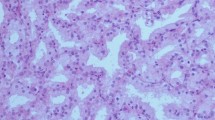Abstract
Radioiodine (RAI) is a well-known radionuclide which is used in vivo both for diagnostic and therapeutic purposes, particularly for the treatment of hyperthyroidism and thyroid cancer. Vitamin E is a well-known antioxidant vitamin. The aim of this study was to evaluate whether there was a protective effect of short-term vitamin E on RAI-induced lacrimal gland early damage in experimental animal models.
Methods
Twentyfour rats were randomly divided into two groups. The first group (RAI group) was administreted 3 mCi 131I by gastric gavage and 1 mL physiological saline intraperitoneally. The second group (RAI + Vitamin E) was administrated 3 mCi 131I by gastric gavage and 1 mL vitamin E intraperitoneally. After 24 h of the last dose being administered on the 7th day, the animals were decapitated. The lacrimal glands [Intraorbital (IG), extraorbital (EG) and harderian glands (HG)] of the rats were removed for histopathological examination.
Results
Periductal and/or periacinar fibrosis in all lacrimal glands were observed to be statistically significantly less frequent in the RAI + Vitamin E group compared to the RAI group. The existence of the abnormal lobular pattern and peripheral basophilia and irregular nucleus shape in IG and in EG, the poorly defined acidophilic cell outline and periductal infiltration in IG and in HG were observed to be statistically significantly less frequent in the RAI + Vitamin E group than in the RAI group.
Conclusion
According to study results, histopathological examinations revealed that vitamin E protects rat lacrimal glands against RAI-related early damage.

Similar content being viewed by others
References
Lee SL. Radioactive iodine therapy. Curr Opin Endocrinol Diabetes Obes. 2012;19:420–8.
Lin WY, Shen YY, Wang SJ. Short-term hazards of low-dose radioiodine ablation therapy in postsurgical thyroid cancer patients. Clin Nucl Med. 1996;21:780–2.
Markitziu A, Lustmann J, Uzieli B, Krausz Y, Chisin R. Salivary and lacrimal gland involvement in a patient who had undergone a thyroidectomy and was treated with radioiodine for thyroid cancer. Oral Surg Oral Med Oral Pathol. 1993;75:318–22.
Zettinig G, Hanselmayer G, Fueger BJ, Hofmann A, Pirich C, Nepp J, et al. Long-term impairment of the lacrimal glands after radioiodine therapy: a cross-sectional study. Eur J Nucl Med Mol Imaging. 2002;29:1428–32.
Silberstein EB. Reducing the incidence of 131I-induced sialadenitis: the role of pilocarpine. J Nucl Med. 2008;49(4):546–9.
Cavalieri RR. Iodine metabolism and thyroid physiology: current concepts. Thyroid. 1997;7:177–81.
Bohuslaviziki KH, Brenner W, Lassmann S, Tinnemeyer S, Tönshoff G, Sippel C, et al. Quantitative salivary gland scintigraphy in the diagnosis of parenchymal damage after treatment with radioiodine. Nucl Med Commun. 1996;17:681–6.
Solans R, Bosch JA, Galofré P, Porta F, Roselló J, Selva-O’Callagan A, et al. Salivary and lacrimal gland dysfunction (sicca syndrome) after radioiodine therapy. J Nucl Med. 2001;42(5):738–43.
Bakheet SM, Hammami MM, Hemidan A, Powe JE, Bajaafar F. Radioiodine secretion in tears. J Nucl Med. 1998;39:1452–4.
Zetting G, Karanikas G, Hanselmayer G, Havlik E, Dudczak R. Radioactive contamination of contact lenses during radioiodine therapy. Nucl Med Commun. 2000;21:955–7.
Capizzi RL, Oster W. Chemoprotective and radioprotective effects of amifostine: an update of clinical trials. Int J Hematol. 2000;72(4):425–35.
Bohuslavizki KH, Klutmann S, Jenicke L, Brenner W, Feyerabend B, Henze E, et al. Radioprotection of salivary glands by S-2-(3-aminopropylamino)-ethylphosphorothioic (amifostine) obtained in a rabbit animal model. Int J Radiat Oncol Biol Phys. 1999;45(1):181–6.
Liu B, Kuang A, Huang R, Zhao Z, Zeng Y, Wang J, et al. Influence of vitamin C on salivary absorbed dose of 131I in thyroid cancer patients: a prospective, randomized, single-blind, controlled trial. J Nucl Med. 2010;51(4):618–23.
Bhartiya US, Raut YS, Joseph LJ, Hawaldar RW, Rao BS. Evaluation of the radioprotective effect of turmeric extract and vitamin E in mice exposed to therapeutic dose of radioiodine. Indian J Clin Biochem. 2008;23(4):382–6.
Koca G, Yalniz-Akkaya Z, Gultekin SS, Yumusak N, Demirel K, Korkmaz M, et al. Radioprotective effect of montelukast sodium in rat lacrimal glands after radioiodine treatment. Rev Esp Med Nucl Imagen Mol. (2013) [Epub ahead of print].
Spitzweg C, Joba W, Schriever K, Goellner JR, Morris JC, Heufelder AE. Analysis of human sodium iodide symporter immunoreactivity in human exocrine glands. J Clin Endocrinol Metab. 1999;84:4178–84.
Nagler RM. Effects of head and neck radiotherapy on major salivary glands-animal studies and human implications. In Vivo. 2003;17:369–75.
Konings AW, Coppes RP, Vissink A. On the mechanism of salivary gland radiosensitivity. Int J Radiat Oncol Biol Phys. 2005;62:1187–94.
Damato BE, Allan D, Murray SB, Lee WR. Senile atrophy of the human lacrimal gland: the contribution of chronic inflammatory disease. Br J Ophthalmol. 1984;68:674–80.
Rios JD, Horikawa Y, Chen LL, Kublin CL, Hodges RR, Dartt DA, et al. Age-dependent alterations in mouse exorbital lacrimal gland structure, innervation and secretory response. Exp Eye Res. 2005;80:477–91.
Bianchi G, Solaroli E, Zaccheroni V, Grossi G, Bargossi AM, Melchionda N, et al. Oxidative stress and anti-oxidant metabolites in patients with hyperthyroidism: effect of treatment. Horm Metab Res. 1999;31:620–4.
Chew EY, Clemons TE, Agrón E, Sperduto RD, Sangiovanni JP, Kurinij N, et al. Long-Term Effects of Vitamins C and E, β-Carotene, and Zinc on Age-Related Macular Degeneration: AREDS Report No. 35. Ophthalmology. 2013. Aug;120(8):1604-11.
Mandel SJ, Mandel L. Radioactive iodine and the salivary glands. Thyroid. 2003;13:265–71.
Ma C, Xie J, Jiang Z, Wang G, Zuo S. Does amifostine have radioprotective effects on salivary glands in high-dose radioactive iodine-treated differentiated thyroid cancer. Eur J Nucl Med Mol Imaging. 2010;37(9):1778–85.
Acknowledgments
The authors haven’t used any sources of public or private financial support.
Conflict of interest
The authors declare that they have no conflict of interest.
Author information
Authors and Affiliations
Corresponding author
Rights and permissions
About this article
Cite this article
Acar, U., Atilgan, H.I., Acar, D.E. et al. The effect of short-term vitamin E against radioiodine-induced early lacrimal gland damage. Ann Nucl Med 27, 886–891 (2013). https://doi.org/10.1007/s12149-013-0763-z
Received:
Accepted:
Published:
Issue Date:
DOI: https://doi.org/10.1007/s12149-013-0763-z




